Andrej Krasnansky, Kanda University of International Studies, Chiba, Japan
Jo Mynard, Kanda University of International Studies, Chiba, Japan
Krasnansky, A., & Mynard, J. (2023). Understanding Our Research Interests: A Synthesis of Publications by Members of a Research Institute. Relay Journal, 6(1), 58-75. https://doi.org/10.37237/relay/060104
[Download paginated PDF version]
*This page reflects the original version of this document. Please see PDF for most recent and updated version.
Abstract
This paper contains a research synthesis of publications by members of the Research Institute for Learner Autonomy Education (RILAE) over a 5-year period. We followed a systematic review process to analyse 163 items and identified the most common kinds of publications. In addition, we conducted an inductive thematic analysis of research themes to determine the main areas of research interest for members. The main areas were psychological constructs related to language learning, self-access and advising. The results are useful for RILAE members when proposing new projects, incoming members or visitors interested in seeing at a glance the kind of works that RILAE researchers publish. In addition, conducting regular research syntheses can monitor how research interests shift over time.
Keywords: Research synthesis, systematic review, secondary research
Authors’ Note
This paper details the process involved in implementing a
synthesis of research by RILAE members. Please click here or on
the thumbnail on the right for an infographic visually
summarising this synthesis. Our write-up is below.
In this paper, we present a synthesis of publications by members of the Research Institute for Learner Autonomy Education (RILAE) over a 5-year period. We conducted the study to summarise the kind of research carried out at RILAE for the following purposes:
-
- To highlight gaps in our work to help RILAE members to identify future projects,
- To help visitors or new members see what kind of research we carry out at RILAE,
- To systematically identify our areas of specialization and interest and
- To be able to compare how our research interests change over time if we continue to conduct this kind of synthesis project every 5 years.
RILAE maintains a list of members’ publications on its website, but until we began this study, it was simply a reference list. Anyone using the list would need to refer to the original paper in order to see what kind of publication it is and what themes each publication includes. One of our main motivations for this study was to make this process easier for anyone interested in RILAE publications.
Conducting systematic reviews of previously published work is a form of secondary research that can overcome the limitations of traditional literature reviews (Ellis, 2015) by reducing researcher bias and allowing for replication of the results. There are two types of systematic reviews: meta-analyses, which focus on quantitative data, and research synthesis, which is a systematic review of qualitative data. Chong and Plonsky (2021) call for more researchers to conduct qualitative research synthesis in the field of TESOL, which can be particularly useful for showing trends in, for example, classroom-based studies that are not generalizable. We felt that conducting a systematic review of RILAE publications would be a useful tool for RILAE members proposing new projects and for new members joining the team.
Background to the Project
The Research Institute for Learner Autonomy Education (RILAE) was established in 2017 at Kanda University of International Studies (KUIS). It is part of the Self-Access Learning Center (SALC), which was originally founded in 2001 and is a social learning community providing resources, facilities, communities and expert support in developing language learner autonomy and English language skills (Mynard et al., 2022). Research has always been an important aspect of the SALC, with the idea that through action research, the SALC can continue to ensure that its services are meeting the needs of KUIS students (Cooker, 2010). With the launch of RILAE in 2017, the scope was broadened so that KUIS could engage more with international research and develop its continuing education resources (for example, the online certificate program in advising). Its website states that RILAE is
a resource for teachers and researchers around the world interested in learner and teacher autonomy. The aim of RILAE is to promote research, professional development, and best practice in developing lifelong and lifewide autonomous learning. (RILAE, n.d.)
This aim is achieved through the following services:
-
- Research projects and support for researchers,
- Free biannual LAb sessions (international webinars) sharing best practices in research and practice of autonomy,
- Opportunities to publish in open-access journals,
- Online courses in the areas of advising, autonomy, teacher leadership and research methods and
- A repository of research links, instruments and data for autonomy-related studies.
RILAE members include SALC staff, learning advisors and teachers at the university who conduct research related to learner autonomy. A small number of RILAE members are scholars from other institutions, both inside and outside Japan, associated with KUIS. At the time of writing, members comprised three full-time researchers, four part-time researchers and around 30 contributing researchers.
RILAE members are free to research any areas of interest within the fields of learner autonomy, teacher autonomy, self-access, advising, the psychology of language learning or other closely related areas. The aim of any member’s research should be to expand our understanding of how languages are learned and how educators can best support learners both inside and outside the classroom. Although members of RILAE are supported in all aspects of the research process by the director and other senior researchers, no specific guidance is given to researchers with regard to their topics. However, they are encouraged to refer to previous research before embarking on a new project and to conduct a preliminary literature review to accompany a project proposal. RILAE members often refer to the list of previous publications by other members as the first step in this process. Synthesizing previous work would be a very helpful tool for RILAE researchers to identify gaps in our knowledge and to plan new projects.
Methodology
Methodological framework: Research synthesis
We drew on methods outlined in detail by Chong and Reinders (2020) and followed an adapted version of the primer suggested by Chong and Plonsky (2021). As we were limiting our data to works published by RILAE members, we simplified the steps somewhat (See Figure 1 for an illustration of our framework); we already possessed a list of items to include, and thus we did not need to identify keywords or conduct a literature search. However, as with other frameworks, our process followed a structure, and each step was undertaken systematically, in this case involving two researchers.
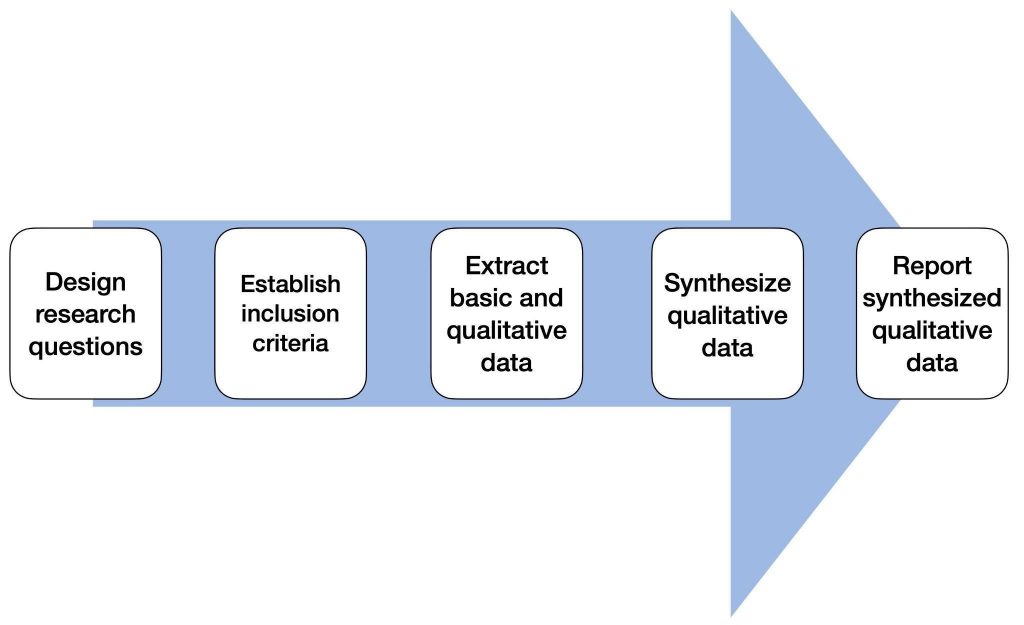
Figure 1. Methodological Framework for Conducting a Synthesis of Published Works
Step 1: Establish research questions
The two research questions guiding the research synthesis were:
RQ1: What kinds of publications do RILAE members produce?
RQ2: What themes are RILAE members interested in?
Step 2: Establish inclusion criteria
In order to answer the research questions, we first had to decide what kind of specific information we would need to synthesize. For practical reasons, we decided to include 5 years of data (2018 to 2022 inclusive), as it would offer a current picture and include sufficient data (163 items) while keeping the project manageable. We did not include conference presentations in this analysis as we were just interested in published works for this project. Presentations may be analysed as part of a future project.
To answer the first research question, we needed to include all publications by RILAE members which were already listed on the RILAE website. To answer RQ2, we included all publications that contained original content, for example, studies, descriptions, research summaries, theoretical papers, position papers and books. We excluded any publications that just summarised other content, i.e., introductions to journal issues and reviews of events. In total, 132 items were analysed for RQ2, as 31 of the original 163 items were excluded.
Step 3: Extract basic and qualitative data
In order to answer the first research question, we extracted the basic data shown in Figure 2, drawing on the suggestions for conducting a synthesis outlined by Chong and Plonsky (2021). We decided on the information from each publication that could be helpful for understanding the kinds of publications that were produced by RILAE members.
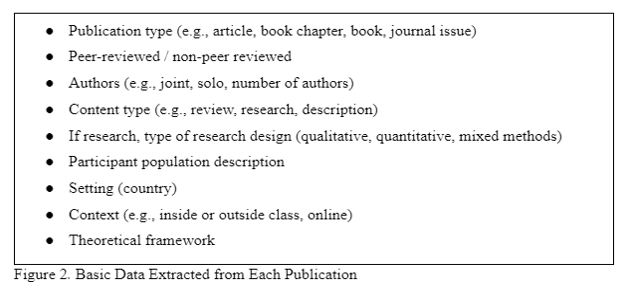
In the first round of analysis, we extracted the basic data from the entire publications list available publicly on the RILAE website and pasted them into a spreadsheet (See Appendix A). We also pasted the abstracts into a separate document for reference (See Appendix B). We completed the basic data extraction by mainly referring to the abstracts, but in some cases, we referred to the original article if the abstracts were not sufficient.
Step 4: Synthesize qualitative data
To answer the second research question, we conducted an inductive thematic analysis of the content of the 132 included items. We collaboratively conducted the initial thematic analysis by manually assigning tentative codes. During this discussion process, we allocated a primary code that best encompassed the theme of the entire item (following Braun & Clark, 2008). In many cases, we also assigned a secondary code. We only did this in cases where there were two clear major themes. In two cases, we assigned three codes. We acknowledge our theoretical positioning but did not use a preexisting framework. Through our discussions, themes emerged from the data itself. We continued to examine the codes both independently and together and met several times over the course of a week to discuss them in detail and, where necessary, rephrase, combine, split or recode.
Step 5: Report synthesized qualitative data
We reported the findings in several ways. First, we created summary tables based on the extracted data (see the results section), a word cloud of the abstracts of the 132 items using NVivo Qualitative software (See Appendix C) and an infographic to summarise the key findings from the entire study (See Figure 3 for the infographic). Infographics in our field are a way ‘to make secondary research easy to read and understand to ESL, EFL, EAP, ESP, ESOL, EAL, TEFL teachers’ (TESOLgraphics, n.d.). They are a valuable resource for busy teachers, researchers and graduate students who might not have the time or access to resources and are interested in reading a synthesis of articles published on a particular topic in under 5 minutes. We also shared our findings with RILAE members at a department meeting and invited them to comment on our analysis.
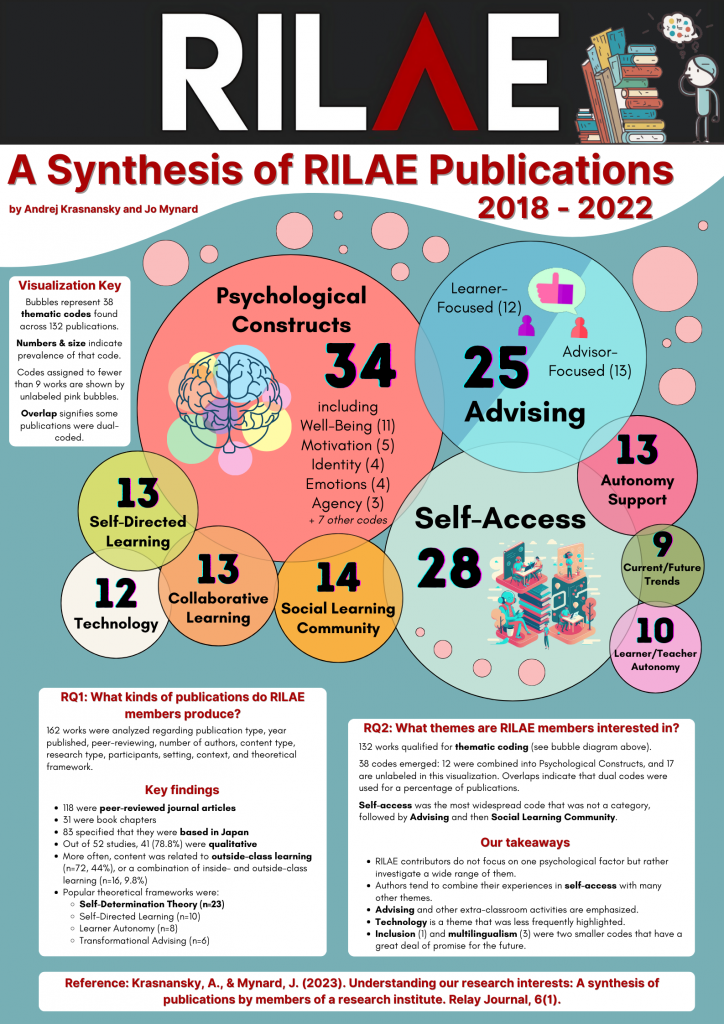
Figure 3. Infographic Summarising the Main Findings
Results
RQ1. Publication types
From the analysis of the basic data we extracted from all 163 items, we could see that the most popular publication types were peer-reviewed journal articles (n = 118, 72.4%) and book chapters (n = 31, 18.9%) and, if specified, were mainly based in the Japan context (n = 83). The most popular types of paper were studies (n = 52, 31.9%), the majority of which were qualitative (n = 41, 78.8%). The majority of research papers used university students as participants (n = 38, 73.1%). There were also a large number of introductions (n = 29, 8.9%) where RILAE members had edited books and journals or journal columns and included an introduction to a collection of papers. Most items were solo-authored (n = 71, 43.6%) or co-authored with one other researcher (n = 52, 31.9%). The content tended to be related to outside-class learning (n = 72, 44.2%), but professional development (n = 17, 10.4%) and a combination of inside- and outside-class learning (n = 16, 9.8%) were also popular. Only 12 items (7.4%) related only to in-class learning. The most popular theoretical frameworks were self-determination theory (Deci & Ryan, 1985; n = 23), self-directed learning (Hiemstra, 1994; n = 10), transformational advising (Kato & Mynard, 2016; n = 6) and learner autonomy (Dam et al., 1990; n = 8). Table 1 shows a summary of the analysis of the broad publication data, and Table 2 shows a more detailed summary of the content of those publications.
Table 1
Summary of Publication Details of Publications by RILAE Members 2018-2022 (N = 163)
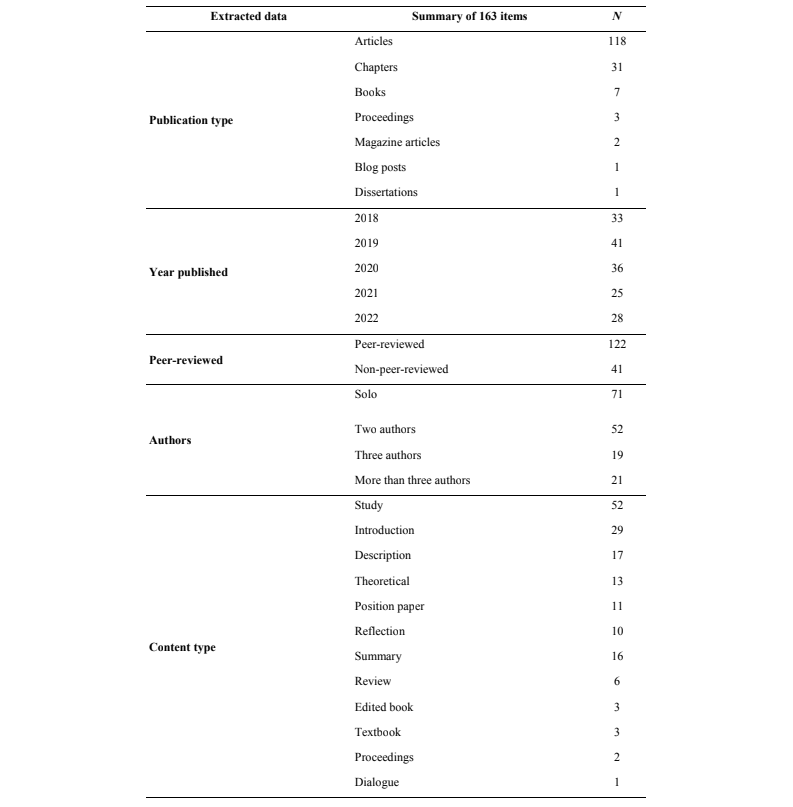
Table 2
Summary of Content Extracted from Publications by RILAE Members 2018-2022 (N = 163)
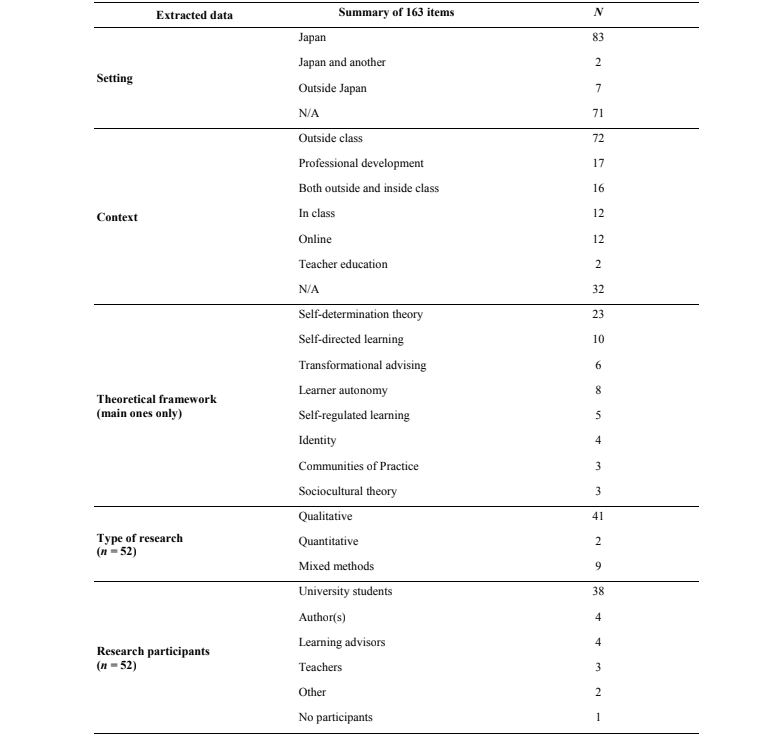
RQ2. Themes
The inductive thematic evaluation indicated that, within the 132 items coded, many researchers were interested in a breadth of ‘Psychological Constructs’ (n = 34). Twelve single codes were subsumed into this larger category code, including themes of ‘Well-Being’ (n = 11), ‘Motivation’ (n = 5), ‘Identity’ (n = 4), ‘Emotions’ (n = 4), ‘Agency’ (n = 3) and seven others. The largest single code was that for ‘Self-Access,’ spanning 28 publications. These 28 items naturally had the most overlap with other codes, such as ‘Autonomy Support’ (n = 7), ‘Social Learning Community’ (n = 4), and 10 other secondary codes. The next-largest single code was ‘Advising’ (n = 25); this code was split almost in half between those focusing on learners (n = 12; i.e., how advising sessions support their autonomous language learning) and those focusing on advisors (n = 13; i.e., advisor mentoring, professional development and reflective practice). Next was ‘Social Learning Community’ (n = 14), with many items stemming from one larger longitudinal ethnographic study. ‘Autonomy Support’ (n = 13), ‘Collaborative Learning’ (n = 13) and ‘Self-Directed Learning’ (n = 13) all ranked as the fourth-largest code groups, and ‘Technology’ (n = 12) was close behind. Overlapping codes were common. For example, the code for ‘Learner/Teacher Autonomy’ (n = 10) was given to two works that were also coded as ‘Current/Future Trends’ (n = 9), which in turn also overlapped with ‘Self-Access,’ ‘Autonomy Support,’ ‘Advising’ and so on. We grouped the 17 remaining smaller codes, spread among 42 items (31.82% of the total 132) together into an ‘Other’ category. Table 3 shows a detailed look at the distribution of codes.
Table 3
Summary of Themes from Published Works by RILAE Members 2018–2022 (N = 132)
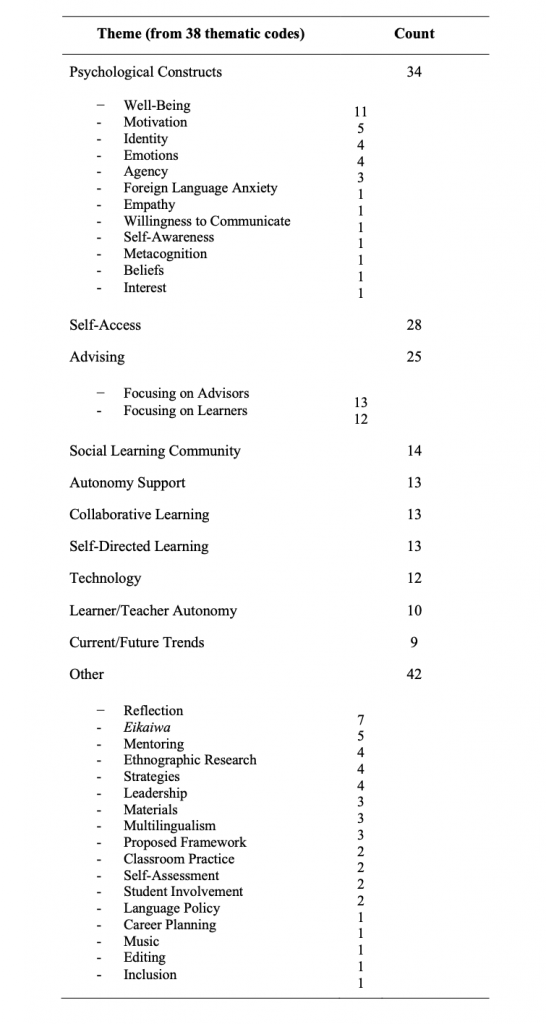
Discussion and Conclusions
From the analysis of the basic data we extracted, we can see that we are mainly concerned with our immediate context, the SALC. RILAE authors tend to focus on support for outside-classroom learning in Japan using qualitative methods. As the mission for RILAE is to become a hub to support international interest in learner autonomy, we call for more international collaborations in the future, for example, encouraging international partners to join RILAE, replicate the studies and collaborate on transnational research projects. Currently, RILAE members are limited to KUIS employees or a small number of collaborators. We are considering a membership option in the future, which will encourage more international involvement. We suggest replicating this synthesis in 5 years’ time to include data from 2023 to 2027 in order to make a comparison with the current synthesis.
Focusing specifically on the results from the thematic analysis, a number of interesting patterns emerged. First, the largest category of codes is the umbrella term ‘Psychological Constructs,’ which consisted of several factors that connect to learning and autonomy. With the exception of ‘Well-Being,’ to which one author contributed six works, RILAE members’ interests in these factors are widespread, with no one factor standing out as a commonality. Diverse interests in motivation, identity, emotions and so on enable contributors to provide multiple perspectives on learners and how best to support them.
As noted in the data collection for RQ1, the context of the SALC was evident, as one of the main themes we discovered was self-access (see Table 3). However, we gave all 28 publications in that code a secondary code, thus showing what a multifaceted concept self-access is. This result highlights a SALC’s role in supporting learners’ psychological as well as linguistic needs. In addition, advising topics were heavily emphasized, stemming again from the immediate context of many of the members, as were other outside-classroom learning activities such as communities or online collaborative learning. Furthermore, although technology was not a primary theme in a large number of the examined works, the willingness to explore online contexts shows promise that this theme will continue to grow.
Finally, some themes that emerged in a small number of works have greater potential than their numbers may suggest. Multilingualism and inclusion are two areas that were under-represented over the past 5 years, but we expect these to be explored much more in the coming year, especially since the SALC mission was recently redefined (Mynard et al., 2022) to specifically feature these aspects. In accordance with our call for international involvement, it is our hope that these important themes will become more prevalent soon.
Notes on the Contributors
Andrej Krasnansky is a Lecturer at Kanda University of International Studies (KUIS) in the English Language Institute. Andrej has been teaching English in Spain and Japan since 2015. His interests include learner engagement, agency, reflection, and second language writing.
Jo Mynard is a Professor and Director of the Self-Access Learning Center (SALC) and Director of the Research Institute for Learner Autonomy Education (RILAE) at Kanda University of International Studies (KUIS) in Japan. She completed her Doctorate in Education (TEFL) at the University of Exeter, UK in 2003 and her M.Phil in Applied Linguistics at Trinity College, Dublin in 1997. Her areas of professional interest are learner autonomy, self-access, advising, reflective dialogue, and social learning spaces.
References
Braun, V., & Clark, V. (2008). Using thematic analysis in psychology. Qualitative Research in Psychology, 3(2), 77–101. https://doi.org/10.1191/1478088706qp063oa
Chong, S. W., & Plonsky, L. (2021). A primer on qualitative research synthesis in TESOL. TESOL Quarterly, 55(3), 1024–1034. https://doi.org/10.1002/tesq.3030
Chong, S. W., & Reinders, H. (2020). Technology-mediated task-based language teaching: A qualitative research synthesis. Language Learning & Technology, 24(3), 70–86. http://hdl.handle.net/10125/44739
Cooker, L. (2010). Some self-access principles. Studies in Self-Access Learning Journal, 1(1), 5–9. https://doi.org/10.37237/010102
Dam, L., Eriksson, R., Little, D., Miliander, J., & Trebbi, T. (1990). Towards a definition of autonomy. In T. Trebbi (Ed.), Third Nordic workshop on developing autonomous learning in the FL classroom. Bergen, August 11–14, 1989: Report (pp. 102–103). https://warwick.ac.uk/fac/soc/al/research/collections/elt_archive/research_projects/dahla/archive/trebbi-1990.pdf
Deci, E. L., & Ryan, R. M. (1985). Intrinsic motivation and self-determination in human behavior. Plenum.
Ellis, R. (2015). Introduction: Complementarity in research syntheses. Applied Linguistics, 36(3), 285–289. https://doi.org/10.1093/applin/amv015
Hiemstra, R. (1994). Self-directed learning. In T. Husen & T. N. Postlethwaite (Eds.), The international encyclopedia of education (2nd ed., pp. 9–19). Pergamon Press.
Research Institute for Learner Autonomy Education. (n.d.). Home: Research, professional education, and practice in autonomy. https://kuis.kandagaigo.ac.jp/rilae/
TESOLgraphics (n.d.). https://www.tesolgraphics.com/
Kato, S., & Mynard, J. (2016). Reflective dialogue: Advising in language learning. Routledge. https://doi.org/10.4324/9781315739649
Mynard, J., Ambinintsoa, D. V., Bennett, P. A., Castro, E., Curry, N., Davies, H., Imamura, Y., Kato, S., Shelton-Strong, S. J., Stevenson, R., Ubukata, H., Watkins, S., Wongsarnpigoon, I., & Yarwood, A. (2022). Reframing self-access: Reviewing the literature and updating a mission statement for a new era. Studies in Self-Access Learning Journal, 13(1), 31–59. https://doi.org/10.37237/130103
Appendices
Appendix A
Data Extraction Spreadsheet
To view the spreadsheet, please follow this external link.
Appendix B
Abstracts of Synthesized Publications
To view the document containing the abstracts, please follow this external link.
Appendix 3
Word Cloud of Top 500 Words From Collated Abstracts of Content Papers (n = 132)
For the appendix, please follow this link.

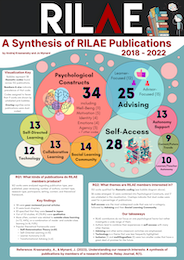
Dear Authors,
I am highly impressed with the authors’ efforts to distill the characteristics of a large number of studies, making complex results more accessible and summarising them in an appealing way.
In the past years, there has been a significant growth in the number of research syntheses in applied linguistics research. While many of those research syntheses in the past aimed to aggregate the results of quantitative research such as correlations, in recent years, there are diverse approaches to synthesising research in the field, as Chong and Plonsky (2023) summarised in their article. Compared to other research synthesis studies, the aim of this study is unique, as it explores the research trends within a specific research institution, where the authors are affiliated. I believe this is one of the illustrative models of an alternative approach to synthesise research, and I look forward to seeing additional studies on this topic conducted by different institutions.
Also, the infographic summary of the main findings effectively communicates the results, making complex and thought-provoking research findings easily understandable to readers. In the field, TESOLgraphics Project (https://www.tesolgraphics.com/) takes an initiative to create summaries of applied linguistics studies and secondary research in the field, aiming to make the research output more accessible and to facilitate research-practice dialogue. Considering the context of the study, it successfully works as a communication tool to articulate the vision among institution members, as well as to connect the institution with external researchers and practitioners.
In the study, data collection and coding were systematically done, and the data were analysed thoroughly and comprehensively. I found the results and discussions provide valuable insights that will be beneficial for my future research, and I would like to pose several inquiries.
・To what extent does the research trend align with the policies or mission statements of the institution? Also, what are the under-researched topics/areas from the perspective of the institution’s policy? Although the authors provide detailed background about the institution, analyses of data and discussions tend to focus simply on the number of publications.
・Regarding the results related to the thematic coding of themes, it is interesting that various psychological constructs were the key areas of inquiry. I wonder if there were any studies that combined more than one themes? For example, In Boo et al.’s (2015) systematic review of L2 motivation research, they pointed out that some studies were exploring more than one concepts in one study. Since the themes emerged in the analysis include both psychological constructs (e.g., well-being, motivation) and research/teaching context (e.g., self-directed learning), I would like to know what kind of combinations such as “motivation in the context of self-directed learning” were found.
・How have the results of the study been utilised within the institution? The study pointed out that there were under-represented research areas and topics, and I wonder how the findings are recognised by the institution members. I think it is very important that the members of the institution understand the research trends, and discuss their current and future research plans drawing on the findings of the study. I would like to know if the authors have received any feedback and comments on the study from the members of the institution.
Finally, I would like to provide a suggestion for future research. The authors suggest replicating the study to compare how research trends change in the next five years. I strongly believe future replications are necessary and will provide additional valuable insights. At the same time, I feel that the future replication does not necessarily need to focus on studies that will be published between 2023 and 2027. I would recommend the authors to take an initiative to create a database of research conducted within the institution, maintaining regular updates (i.e., adding newly-published article to the spreadsheet attached as Appendix A), and conducting annual analyses. Additionally, sharing the database with members of the institution would be effective. By doing so, members can utilise the database when formulating plans for new research projects and when reviewing previous studies conducted in the institution.
Thank you for the opportunity to read your article. I appreciate the insights it provided, and I look forward to the opportunity to explore your upcoming research articles.
References
Boo, Z., Dörnyei, Z., & Ryan, S. (2015). L2 motivation research 2005–2014: Understanding a publication surge and a changing landscape. System, 55, 145–157. https://doi.org/10.1016/j.system.2015.10.006
Chong, S. W. & Plonsky, L. (2023). A typology of secondary research in Applied Linguistics. Applied Linguistics Review. https://doi.org/10.1515/applirev-2022-0189
TESOLgraphics (n.d.). The TESOLgraphics Project. https://www.tesolgraphics.com/about.html
Dear Takumi,
Thank you so much for reading our paper and responding with such excellent and thought-provoking questions. You really helped us to think more deeply about our work and we really appreciate it.
We will respond to your specific questions below.
・To what extent does the research trend align with the policies or mission statements of the institution? Also, what are the under-researched topics/areas from the perspective of the institution’s policy? Although the authors provide detailed background about the institution, analyses of data and discussions tend to focus simply on the number of publications.
The mission statement of our institution is focused on promoting research in learner and teacher autonomy. The results show that 23 publications were coded with the primary themes of Autonomy Support and Learner/Teacher Autonomy, thus we feel that autonomy is a significant focus in the research of our members. Further, many other themes are related to autonomy, but those publications were not coded as such due to a more salient primary focus. For example, a paper that was coded with Self-Directed Learning and Technology themes (Ambinintsoa et al., 2021) was also concerned with how learners take charge of their language learning with specific technology. An additional discussion of how our focus on autonomy is validated by our findings may be warranted in the Discussions and Conclusions section. As for the second part of your question here, we did note the research trend of focusing on outside-classroom learning in our immediate context of Japan, and we called for “more international collaborations in the future.” We also hoped that the areas of multilingualism and inclusion would be more taken up by members in the near future, although it remains to be seen how much.
・Regarding the results related to the thematic coding of themes, it is interesting that various psychological constructs were the key areas of inquiry. I wonder if there were any studies that combined more than one themes? For example, In Boo et al.’s (2015) systematic review of L2 motivation research, they pointed out that some studies were exploring more than one concepts in one study. Since the themes emerged in the analysis include both psychological constructs (e.g., well-being, motivation) and research/teaching context (e.g., self-directed learning), I would like to know what kind of combinations such as “motivation in the context of self-directed learning” were found.
We endeavored to highlight the most salient themes, but the overlaps can indeed tell a more-complete story about each article. However, there were not many consistent overlaps with each Psychological Construct. One exception to this rule was the code of “Identity,” applied to 4 publications, 3 of which were also coded “Social Learning Communities.” On the other hand, the five studies coded as “Motivation” had five distinct overlaps, three with “Reflection,” “Career Planning,” and “Self-Directed Learning,” but two with two other Psychological Constructs, “Well-Being” and “Interest.”
It is, however, interesting to see how the psychological constructs altogether are applied to different areas. We will expand on this when we update our final version of the paper – thank you for highlighting this point. In the revised version of the paper, we will include the following information in the findings section:
Codes that overlap with any Psychological Construct, n
Reflection, 4
Collaborative Learning, 4
Self-Directed Learning, 4
Social Learning Communities, 3
Motivation, 2
Advising (Advisor-Focus), 2
Advising (Learner-Focus), 1
Mentoring, 1
Classroom Practices, 1
Eikaiwa, 1
Career Planning, 1
Self-Access, 1
As we were checking the studies again, we noticed a small error that we will correct in the updated version – we should have written that there were 34 studies (not 33) that fell under the umbrella term “Psychological Constructs” as one paper coded “Agency” was not also coded in that category.
・How have the results of the study been utilised within the institution? The study pointed out that there were under-represented research areas and topics, and I wonder how the findings are recognised by the institution members. I think it is very important that the members of the institution understand the research trends, and discuss their current and future research plans drawing on the findings of the study. I would like to know if the authors have received any feedback and comments on the study from the members of the institution.
Thanks for this suggestion. We completely agree. We have regular meetings with the research team and we shared the preliminary findings in January 2023. We will share the findings again in April or May 2024 – the beginning of our academic year and use the findings as a springboard for discussion about our research priorities for this academic year.
Finally, I would like to provide a suggestion for future research. The authors suggest replicating the study to compare how research trends change in the next five years. I strongly believe future replications are necessary and will provide additional valuable insights. At the same time, I feel that the future replication does not necessarily need to focus on studies that will be published between 2023 and 2027. I would recommend the authors to take an initiative to create a database of research conducted within the institution, maintaining regular updates (i.e., adding newly-published article to the spreadsheet attached as Appendix A), and conducting annual analyses. Additionally, sharing the database with members of the institution would be effective. By doing so, members can utilise the database when formulating plans for new research projects and when reviewing previous studies conducted in the institution.
This is an excellent idea – thank you for the suggestion! We already have an internal spreadsheet for work in progress so it would only be a minor step to maintain the public spread sheet at the same time. This will actually make it easier to replicate this process in the five years’ time to monitor our growth and research directions.